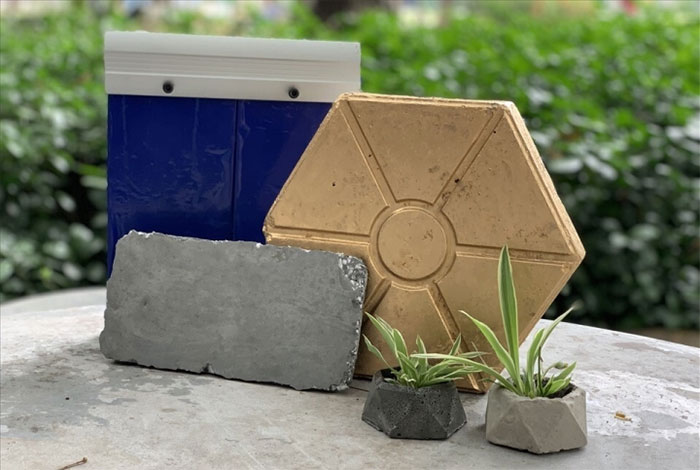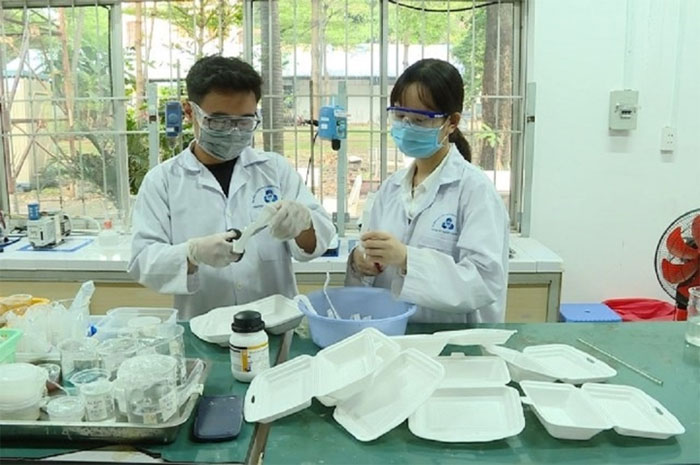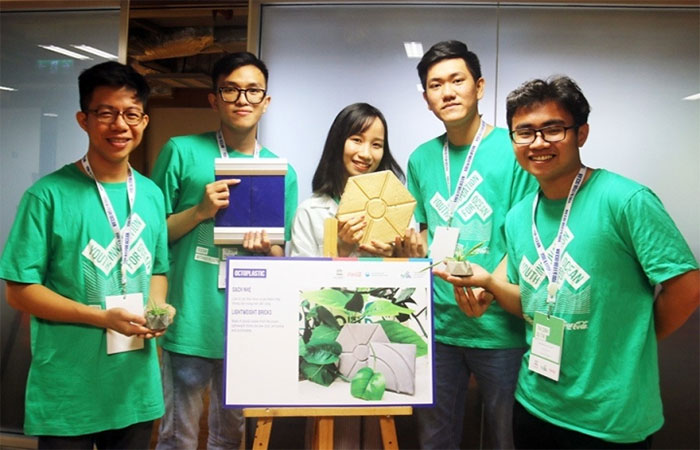La Dan Hy and a group of students from the University of Science and Technology (Vietnam National University, Ho Chi Minh City) have transformed plastic waste into lightweight bricks, creating economic value.
In July 2020, a group of friends including Dan Hy, Nguyen Phuong, Thanh Dat, Thien Tu, and Minh Tuan, students from the Department of Chemical Engineering at the University of Science and Technology (Vietnam National University, Ho Chi Minh City), established the Octoplastic group with the aim of applying their academic knowledge to real-world recycling practices to protect the environment.

Bricks made from plastic waste by the Octoplastic group. (Photo: Provided by the group)
Failures Do Not Discourage
La Dan Hy, the group leader, noted that according to statistics, approximately 8 million tons of plastic waste are dumped into the oceans worldwide each year. In Vietnam alone, between 0.28 to 0.73 million tons of plastic waste are released into the oceans annually, accounting for 6% of the global total and ranking fourth in the world (according to a representative from the United Nations Environment Programme).
The amount of single-use plastics such as plastic cups, spoons, and containers is increasingly favored for their convenience and lightweight nature. However, their non-biodegradability has severely impacted the environment, especially marine ecosystems.
The plastic waste (including PS – Polystyrene) dumped into the oceans complicates collection and processing efforts, detracting from aesthetics and negatively affecting marine ecosystems. Hence, the Octoplastic group conceptualized a model for “Producing Lightweight Bricks from Waste Materials” with the hope of addressing this issue.
“Reusing non-recyclable plastic materials will help alleviate the burden of waste and reduce soil and water pollution caused by improper waste disposal. Additionally, the group’s idea aims to utilize waste as construction material, raising public awareness about waste reuse,” Dan Hy stated.
From July to November 2020, these young students worked tirelessly, often losing track of time, focused on discovering a formula for recycling plastic to help lessen the “burden” on the oceans.
The materials chosen by the group included Polystyrene products such as plastic containers, foam food boxes, and plastic cups. Polystyrene is known to be difficult to recycle, so initially, the group faced significant challenges in finding research materials for reference. They had to conduct numerous experiments to find optimal results.
Dan Hy shared that during the process, the group encountered many difficulties in designing the synthesis process for the product, as they could not find the desired reference materials since the production process for this type of material has not been widely applied in practice. Consequently, the group had to experiment over 30 times for several months, encountering many errors before identifying the most suitable parameters for the product.
Interestingly, during the lab experiments at their school, the group used discarded food containers from trash bins to create their products. After identifying the materials, they all cleaned, dried, cut, and finely ground them. Next, the plastic was mixed with a combination of binding agents. The final step was to dry and cure the mixture.
“When the first bricks were formed, the group was very excited but disappointed because the bricks did not meet expectations. They were not sturdy and could be easily broken by hand. However, we encouraged each other, remained determined, and continued focusing on research. Eventually, we found the ‘golden ratio’ of binding agents and Polystyrene at a 50-50 ratio,” Dan Hy shared.

The group used discarded food containers to make bricks. (Photo: Lam Dong Radio and Television)
Economically Beneficial and Good for the Oceans
According to Dan Hy, the brick samples produced by the group currently meet the M50 compressive strength standard of Vietnam (TCVN 1450:2009). The bricks made from readily available waste materials like Polystyrene and fly ash are very cost-effective to produce, and the simple process leads to high sustainability.
With this process, many households can produce bricks without needing complex equipment, resulting in high economic benefits. Importantly, if more people utilize plastic waste to make bricks, rivers, lakes, and oceans will no longer be burdened by plastic waste, leading to a cleaner, greener ecosystem and improved human life, significantly reducing the risks posed by climate change.
“Although the bricks are made from plastic, they are lightweight and have better sound and thermal insulation properties than conventional bricks. They contribute to solving plastic waste at the source, replacing old waste processing methods that have many limitations, while providing economic benefits and being good for the oceans and the environment,” Dan Hy stated.
Additionally, the product offers various practical values such as being used for flooring, beach house foundations, or soundproof wall coverings in studios and hotels… Depending on the application and characteristics, the products come in various shapes (square, round, hexagonal, etc.) and corresponding colors.
“The current formula is already optimized, but the group will continue to improve the quality of the bricks. In the near future, we will register for copyright and test on an industrial scale, while also researching new features for the product,” Dan Hy said.

Five members of Octoplastic with their product. (Photo: Provided by the group)
The efforts of the Octoplastic group for the environment were rewarded when their project won second place in the “Search for Creative Ideas for a Plastic-Free Ocean” competition held by UNESCO in 2020.
Through their activities, the five members of Octoplastic hope to contribute to building a clean and green ocean. Additionally, they aim to spread their message and ideas closer to the community.


















































